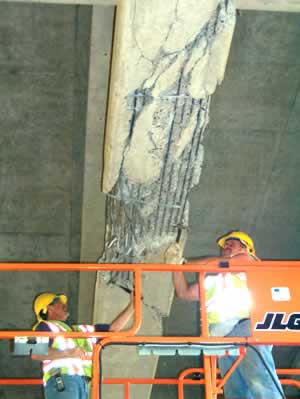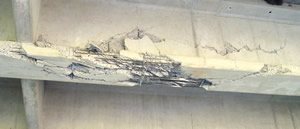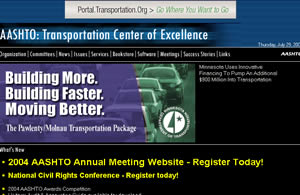 |
 |
|
 |
Swift uppercuts from backhoe KO girders on Hwy 95 bridge |
 |
 |
 |
|
St. Cloud bridge workers Mike McCann (left) and Duane
Mehr remove loose concrete to prevent it from falling onto vehicles passing
under the bridge. Bridge maintenance crews also used a spray-on form of
concrete to cover exposed cables and keep them from rusting. Photo
by Steve Kavanagh
|
Three concrete girders on the Hwy 95 bridge over Hwy 169 near Princeton were
badly damaged when a backhoe riding too high on a trailer hit one girder, then
struck two more after springing back from the first impact.
The force of the impact knocked out one girder span from the bridge's center
support to its east end. Four of the 40 steel cables in one pre-stressed concrete
girder were ripped out by the crash. Another girder suffered the loss of six
steel cables. All of the damaged beams are 90 feet, 10 inches long.
One other girder received extensive damage as well. Two of three girders damaged
require replacement, said Steve Kavanagh, bridge maintenance superintendent
at St. Cloud. Mn/DOT officials initially considered closing the bridge, but
later determined safe travel could be maintained by ensuring that traffic doesn't
pass directly over the affected beams.
The incident occurred June 28.
That means that until repairs are completed, the shoulder access remains closed,
prohibiting over-weight and over-dimension trucks from stressing the damaged
girders under the bridge's southbound lanes.
"I've never seen a hit this bad; it looks like there's shattered glass
all over the place," said Kavanagh.
The damage cost, he said, is similar to that suffered when a truck
struck a bridge pier on I-90 near Worthington last year and an incident
in 1994 that severely damaged an I-94 bridge near Monticello.
Kavanagh said bridge decking over the damaged girders will have to be removed
to allow installation of new ones. Contract repair work will begin in mid-August,
he said, if new girders are available from a certified manufacturer.
Kavanagh said the trailer's owner has been identified and will have to pay
for the damage.
 |
|
Exposed steel cables dangle from one of the pre-stressed
concrete beams hit by the backhoe. Photo by Steve Kavanagh
|
The Bridge Office helped the district assess the damage and determine the extent
of needed repairs on the two-lane, 25-year-old structure.
"This is as bad a situation like this that I've ever seen," said
Gary Peterson, construction maintenance engineer, Bridge Office. "The impact
moved the bottoms of the girders several inches laterally, causing extensive
cracking and other damage," he said.
"As severe as the damage is, though, it tells us that even a beam with
six of its 40 cable strands broken still has enough reserve strength to ensure
the public is not at risk when using the bridge," Peterson said.
By Craig Wilkins
|
back

|
 |
Interregional corridors system adds 38 miles |
 |
 |
 |
|
Commissioner's staff approved the extension of the
interregional corridor system from 2,922 miles to 2,960 miles on July
19. The red lines indicate interregional corridors of high priority and
the green lines are interregional corridors of medium priority. The blue
lines signify regional corridors.
|
Minnesota just acquired more miles of interregional corridors--38 more miles
to be exact.
Commissioner's staff approved the extension of the interregional corridor system
from 2,922 miles to 2,960 miles on July 19. A new
interregional corridor system map was developed that reflects the addition
of some interregional corridors and the extension of others. It also reflects
changes to the priority level of some important Minnesota cities or "regional
trade centers."
Interregional corridors help Mn/DOT determine where major roadway investments
should be made. They are highways that may be improved rather than just maintained
or that will receive construction funds more quickly.
"The changes won't have much of an effect on the system as a whole,"
said Dick Bautch, Interregional Corridor Program manager. "But for districts
with regional trade centers like Mankato, which hasn't increased in level of
priority, or Cambridge, which has increased, the first thought is that their
interregional corridor funding status could change."
However, changes in priority of regional trade centers are not the only criteria
that determine funding allocations to interregional corridors.
"Traffic growth trends and signal proliferation can affect safety and
mobility on our interregional corridors," Bautch said. "Mn/DOT and
the Legislature also look at these and other factors before making funding decisions."
The term "interregional corridor" was adopted by Mn/DOT in 1999 during
the statewide transportation planning process. It's really just a fancy name
for a state highway that provides a connection to an important Minnesota city
or "regional trade center."
"Interregional corridors tie the state together by connecting people with
jobs, distributors with manufacturers, shoppers with retailers and tourists
with recreational opportunities," said Randy Halvorson, Program Management
Division director. "Interregional corridors are important to the state
economy by moving people and goods safely and efficiently."
The interregional corridor system represents only two percent of state roadway
miles, but accounts for one-third of all vehicle miles traveled. Traffic volumes
on the system have risen by 50 percent in the last 10 years and are expected
to double by the year 2020.
For more information about interregional corridors, visit the Mn/DOT IRC Web
site at www.dot.state.mn.us/information/irc.html
or contact Bautch at 507/389-3259.
By Donna Lindberg
|
back

|
 |
Web site provides new resource for Minnesota tribes and transportation issues |
 |
 |
After several years of research and planning, a Minnesota Tribes and Transportation
Web site is now available as an online resource guide for doing business with
Minnesota's Indian tribes.
Lt. Gov./Commissioner Carol Molnau presented the Web site to the Indian Affairs
Council last week. The council, established in 1963, is the official liaison
between the state and the 11 tribal governments within Minnesota.
The Web site is the result of collaboration by Mn/DOT, the Federal Highway
Administration and the Minnesota tribes. A multi-jurisdictional committee of
Mn/DOT, FHWA, the Headwaters Regional Development Commission and Minnesota cities
and counties developed content for the site.
The online handbook evolved from the Government-to-Government Tribal Accord
signed at the Tribes
and Transportation Summit in April 2002. The accord reflects the commitment
of Mn/DOT, FHWA and 11 Minnesota Tribes to strengthen relationships, establish
partnerships and work cooperatively on transportation issues of mutual concern.
This online resource offers important information about how to do business
with Minnesota tribes. Visitors to the site can access a variety of information
including agreements, policies, jobs, public involvement, environmental issues,
funding, Indian Reservation Roads program, jurisdiction and laws, planning and
right of way. There is also a section on frequently asked questions and a glossary
to help understand the terms used in the handbook.
To view the site click onto www.dot.state.mn.us/mntribes/handbook.
By Judy Jacobs, Detroit Lakes/District 4 public affairs coordinator
|
back

|
 |
RTMC receives national recognition |
 |
 |
 |
|
From left are Jim Kranig, RTMC director, Lt.
Gov./Commissioner Carol Molnau and Chief Anne Beers, State Patrol. Photo
by Clare Lackey
|
Mn/DOT was one of two state transportation agencies that received recognition
for its transportation management center from ITS America's Transportation System
Operations and Planning Forum.
The Rhode Island Transportation Management Center also received national recognition
this year.
Marthand Nookala, Operations, Safety and Technology Division director, accepted
the trophy on Mn/DOT's behalf at the ITS America Annual Meeting in San Antonio
in April. The department held a special ceremony at the Regional Transportation
Management Center in Roseville on June 15. Lt. Gov./ Commissioner Carol Molnau
and Colonel Anne Beers of the Minnesota State Patrol were on hand to congratulate
the approximately 75 Mn/DOT and 25 State Patrol employees who staff the center.
The RTMC is the second generation of Mn/DOT's transportation management centers
in the Twin Cities area. It became operational for freeway traffic management
in April 2003 and, a month later, for highway maintenance and State Patrol dispatching,
according to Jim Kranig, RTMC director. The RTMC integrates freeway management,
Metro District maintenance dispatching and State Patrol 911 center/dispatching
activities to minimize congestion and to maximize safety and efficiency for
travelers in the Twin Cities metro area.
The first TMC began operating in 1972 to manage traffic for the busiest freeway
segment in the Twin Cities by using ramp metering. Between 1972 and spring 2003,
the role of the center expanded to cover about 80 percent of the Twin Cities
area's freeway miles. The traffic management tools used also expanded and now
include:
290 video cameras
- 4,200 loop detectors
- 419 ramp meters
- 86 dynamic message signs
- Seven sites with lane control signals
- 511 telephone and 511mn.org traveler information programs
- High occupancy vehicle diamond lanes and reversible lanes
- FIRST (Freeway Incident Response Safety Team) with eight routes
- Research and development
"While we are very proud of this state-of-the-art, and now award-winning,
transportation management center, we are especially proud of the staff from
Mn/DOT and the State Patrol who have been instrumental the creation and operation
of the center," Kranig said.
|
back

|
 |
Duluth's Jim Syria helps protect rare flowers during highway improvement project
|
 |
 |
 |
|
Pink and white lady's slippers bloom near a roadside
in northeastern Minnesota. Photo by Jim Syria
|
Stands of rare pink and white lady's slippers near a highway project remain
intact due to Duluth/District 1's Jim Syria's efforts to protect them during
a recent highway improvement project.
Syria learned about the existence of one stand of flowers from the Department
of Natural Resources and then found others in the project area as well.
The Legislature designated the pink and white lady's slipper as the state flower
in 1902. The flower is also known as the showy lady's slipper. State law makes
it illegal to pick these flowers, move the plants or otherwise disturb their
natural development.
The project involved replacing culverts on a highway south of Duluth. Syria
said he and other project staff members gained assurances from the contractor
and others working in the area that the flowers would not be disturbed.
Lady's slippers are members of the orchid family. They flourish in sunlight
and dry woods at low elevations. The plants live for as long as 50 years and
can reach four feet in height.
Syria, a 20-year Mn/DOT veteran, grows flowers with his spouse, Cindy Syria,
also a District 1 employee, at their home near Saginaw. He enjoys photographing
them as well. DNR's Parks Division in Grand Rapids may use a set of his photos
for educational use.
The improvement project ended July 23; Syria's current assignment is in concrete
batch plant in Duluth where the existence of lady's slippers is most unlikely.
He will, however, keep looking and photographing what he finds with a camera
he received recently as a birthday gift.
"With my new camera I've seen things I hadn't noticed before even in my
own yard," he said.
By Craig Wilkins
|
back

|
 |
St. Cloud's Metro Bus dominates annual bus roadeo |
 |
 |
 |
|
Jim Anderson, a program director with the Office of Transit, strides
toward the next event he judged during the annual Statewide Transit
Roadeo held in St. Cloud on July 24. Photo by Traci Vibo
|
One might suspect the home field advantage, but bus drivers from St. Cloud's
Metro Bus system placed four of the top eight scorers through skill and determination
in the 17th annual Statewide Bus Roadeo held July 24 in St. Cloud.
The St. Cloud area's transit system continued its strong showings in recent
competitions that simulate the challenging conditions that bus drivers face
in their everyday work.
Driver Ken Rakke won first place in the large bus division, a feat he also
accomplished in 2002. His co-worker, Duane Dufner, placed second. Rakke and
Dufner were invited to the national roadeo this year after winning in the Minnesota
event. Rakke participated in 2002 and Dufner in 1995.
Drivers Darell Hanson and Marshall Freeman, both from the Twin Cities Metro
Transit, placed third and fourth in the large bus competition.
Two other St. Cloud drivers, Tony Decker and Todd DeZurick, placed third and
fourth, respectively, in the small bus competition.
Roger Benitt, a driver with the Tri-Valley Heartland Express based in Crookston,
took top honors in the small bus event; Dennis Smith from the Heartland Express
based in Granite Falls finished in second place.
Transit systems in rural areas typically use the smaller buses, usually about
25 feet in length. The larger buses, 35 feet in length or longer, are used in
fixed-route service by larger systems such as the Twin Cities, St. Cloud, Duluth
and Rochester.
Mn/DOT and the state's Rural Transportation Assistance Program sponsor the
annual roadeo. St. Cloud's Metro Bus hosted the event, which was held on the
St. Cloud State University campus.
Dave Tripp, St. Cloud Metro Bus executive director, said the event helps focus
attention on the role transit plays in Minnesotans' participation in their work,
school, family and community lives.
"The first statewide roadeo started in St. Cloud 17 years ago," Tripp
said. "It was then and remains today truly a drivers' event. Some of the
maneuvers are amazing; they show the skills that operators must have to drive
safely out there on the street every day."
By Craig Wilkins |
back

|
 |
State's self-service Web site adds new feature |
 |
 |
Minnesota's employee self-service Web site has added a new feature page called
My Personal Information. This service allows state employees to view and
electronically update personal information as needed.
The page contains information such as employees' names, marital status, e-mail
addresses, phone numbers and emergency contact information. Employees can update
their information by logging on to the Web site using their self-service ID
and password (the same ones they use to access pay stub information online).
"Using this feature streamlines data entry efforts within our office and
makes things easier and more accessible for the employees," said Mike Garza,
Office of Business and Support Services director.
Garza said the employee self-service site has several safeguards in place to
prevent unauthorized access to employee data.
"This is a department of Finance initiative and it appears as though they
are taking all necessary measures to ensure employee information is guarded,"
said Garza. "But we need employees to do their part by not sharing their
passwords or having a password that is easily identifiable.
"We want employees to feel comfortable using this service," said
Garza. "There are so many benefits this self-service site providesólike
the ability to offer real-time answers to the employees' human resources and
payroll-related questions and the ability to request changes to their information
according to their schedules and needs."
Employees can view the My Personal Information page by logging on to
www.state.mn.us/employee, where
they review their pay stubs.
"I encourage employees to familiarize themselves with the site,"
said Garza. "As technology continues to develop, we can expect to see more
and more services provided electronically as they do provide a better service
to employees."
By Daneeka Marshall-Oquendo
|
back

|
 |
AASHTO Web site showcases Mn/DOT's use of innovative transportation financing |
 |
 |
 |
|
AASHTO's Web site features a Mn/DOT "success story"
this week: the innovative financing techniques the department is using
to deliver the largest transportation investment program in state history. |
The innovative financing techniques Mn/DOT is using to undertake the largest
transportation investment program in state history is this week's "success
story" featured on the American Association of State Highway and Transportation
Officials' Web site.
Each week AASHTO highlights a successful initiative or program from a different
transportation department. Recent features include Louisiana's environmental
streamlining success, Idaho's pilot program for improving rural transit for
seniors and disabled citizens, and Maryland's public education program to persuade
citizens on the value of express toll lanes as a congestion-relief option.
To read Mn/DOT's feature, click on AASHTO
success stories.
The site also archives past
success stories, including those about Mn/DOT's railroad
crossing safety campaign and former Mn/DOT Commissioner Elwyn Tinklenberg's
testimony before Congress on intelligent
transportation systems.
|
back

|
 |
|
 |



